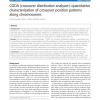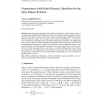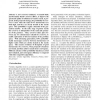102
click to vote
BMCBI
2011
14 years 7 months ago
2011
Background: During meiosis, homologous chromosomes exchange segments via the formation of crossovers. This phenomenon is highly regulated; in particular, crossovers are distribute...
118
Voted
GECCO
2009
Springer
14 years 10 months ago
2009
Springer
We deepen the theoretical analysis of the genetic algorithm for the all-pairs shortest path problem proposed by Doerr, Happ and Klein (GECCO 2008). We show that the growth of the ...
119
Voted
EC
2002
15 years 16 days ago
2002
It is supposed that the finite search space has certain symmetries which can be described in terms of a group of permutations acting upon it. If crossover and mutation respect th...
99
Voted
INFORMATICALT
2006
15 years 22 days ago
2006
Recently, genetic algorithms (GAs) and their hybrids have achieved great success in solving difficult combinatorial optimization problems. In this paper, the issues related to the ...
97
Voted
GECCO
2008
Springer
15 years 1 months ago
2008
Springer
We propose a new class of crossover operators for genetic algorithms (CrossNet) which use a network-based (or graphbased) chromosomal representation. We designed CrossNet with the...
109
Voted
IJCAI
2007
15 years 2 months ago
2007
A matrix formulation for an adaptive genetic algorithm is developed using mutation matrix and crossover matrix. Selection, mutation, and crossover are all parameter-free in the se...
104
click to vote
CEC
2005
IEEE
15 years 2 months ago
2005
IEEE
A new crossover technique, we named Rank and Proximity Based Crossover (RPC), to improve the speed and quality of solutions in Genetic search, is proposed. In the proposed strategy...
110
Voted
GECCO
2000
Springer
15 years 4 months ago
2000
Springer
During chemical reactions, molecules interact to produce new molecules. Some of the reaction mechanisms are very close to the way gene combine to produce new genes. Like the class...
GECCO
2006
Springer
15 years 4 months ago
2006
Springer
Spatial based gene selection for division of chromosomes used by crossover operators is proposed for three-dimensional problems. This spatial selection is shown to preserve more g...
141
click to vote
GECCO
2003
Springer
15 years 6 months ago
2003
Springer
Complex representation in Genetic Algorithms and pattern in real problems limits the effect of crossover to construct better pattern from sporadic building blocks. Instead of intro...





